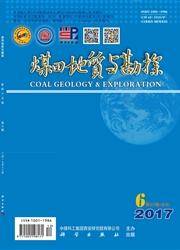

 中文摘要:
中文摘要:
分析隐伏逆冲构造变形特征,揭示构造形成机制,开展构造预测,指导煤地质勘查。通过地表精细观测、二维地震勘探及钻探工程验证等综合方法,在发现并了解其形态学特征基础上,分析表层构造与深部构造耦合关系,结合古构造应力场,阐述构造成因。结果发现南北向深部隐伏逆冲构造,西倾东冲,断面倾角为20°~35°,断于石盒子组内和下伏含煤岩系及其基底内,地层垂直断距为190~260m,水平断距260~470m;浅部地层表现为同向展布的不对称背斜构造,二者空间上密切共生,几何学和运动学具相关性,成因上具统一性;浅层背斜构造是深层逆冲作用控制下断展褶皱作用的结果。隐伏逆冲构造是燕山运动中期盆地内部因阻抗来自东侧构造挤压应力,而产生的反向逆冲构造作用响应。该逆冲构造错断煤层,造成煤层重复,控制了煤层的空间分布,构成韩城矿区南中深部重要的构造边界。
 英文摘要:
英文摘要:
To guide geological exploration, the Paper analyzed the deformation characteristics of concealed thrust fault, revealed the formation mechanism of the fault, carred out the structural prediction. Through the fine surface observation, 2D seismic exploration and verification of drilling engineering, on the basis of discovery and understanding of the morphological features of structures, the coupling relationship between shallow structures and deep structures was analyzed. In combination with the stress field of paleostrcture, the genesis of structures was elaborated.The results showed that the north-south and deep concealed thrust faults were dipping to the west and thrusting to the east, the dip of the fault plan is 20°~35°. The faulting took place inside Shihezi Formation, underlying coal-bearing measures and their basement. The vertical throw is 190~260 m, the horizontal displacement is 260~470 m. The shallow strata occurred as unidirectional assymmetrical anticlines. The shallow strata and the deep strata were closely associated in space, interrelated in geometry and kinematics, unified in genesis. The shallow anticline was the result of fault-propagation folding under control of deep overthrusting. The concealed thrust-fault was the response to the reverse thrust faulting induced by the tectonic crushing stress in the basin during middle Yanshan orogeny. The thrust fault dislocated coal seams, led to repetition of seams, controlled the spatial distribution of coal seams, constituted important tectonic boundary in the mid and deep part of the south of Hancheng mining area.
 同期刊论文项目
同期刊论文项目
 同项目期刊论文
同项目期刊论文
 期刊信息
期刊信息
